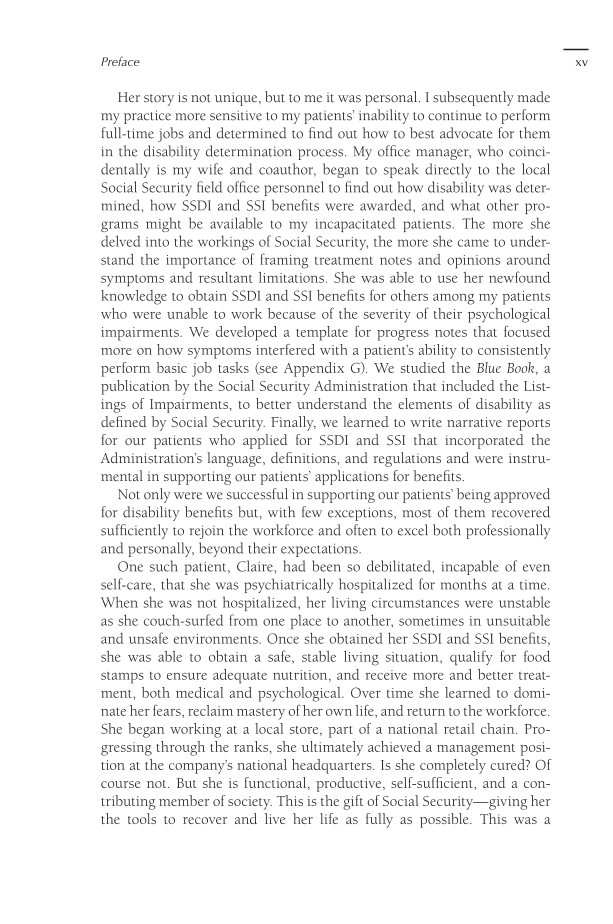Preface xv Her story is not unique, but to me it was personal. I subsequently made my practice more sensitive to my patients’ inability to continue to perform full-time jobs and determined to find out how to best advocate for them in the disability determination process. My office manager, who coinci- dentally is my wife and coauthor, began to speak directly to the local Social Security field office personnel to find out how disability was deter- mined, how SSDI and SSI benefits were awarded, and what other pro- grams might be available to my incapacitated patients. The more she delved into the workings of Social Security, the more she came to under- stand the importance of framing treatment notes and opinions around symptoms and resultant limitations. She was able to use her newfound knowledge to obtain SSDI and SSI benefits for others among my patients who were unable to work because of the severity of their psychological impairments. We developed a template for progress notes that focused more on how symptoms interfered with a patient’s ability to consistently perform basic job tasks (see Appendix G). We studied the Blue Book, a publication by the Social Security Administration that included the List- ings of Impairments, to better understand the elements of disability as defined by Social Security. Finally, we learned to write narrative reports for our patients who applied for SSDI and SSI that incorporated the Administration’s language, definitions, and regulations and were instru- mental in supporting our patients’ applications for benefits. Not only were we successful in supporting our patients’ being approved for disability benefits but, with few exceptions, most of them recovered sufficiently to rejoin the workforce and often to excel both professionally and personally, beyond their expectations. One such patient, Claire, had been so debilitated, incapable of even self-care, that she was psychiatrically hospitalized for months at a time. When she was not hospitalized, her living circumstances were unstable as she couch-surfed from one place to another, sometimes in unsuitable and unsafe environments. Once she obtained her SSDI and SSI benefits, she was able to obtain a safe, stable living situation, qualify for food stamps to ensure adequate nutrition, and receive more and better treat- ment, both medical and psychological. Over time she learned to domi- nate her fears, reclaim mastery of her own life, and return to the workforce. She began working at a local store, part of a national retail chain. Pro- gressing through the ranks, she ultimately achieved a management posi- tion at the company’s national headquarters. Is she completely cured? Of course not. But she is functional, productive, self-sufficient, and a con- tributing member of society. This is the gift of Social Security—giving her the tools to recover and live her life as fully as possible. This was a
Document Details My Account Print multiple pages
Print
You have printed 0 times in the last 24 hours.
Your print count will reset on at .
You may print 0 more time(s) before then.
You may print a maximum of 0 pages at a time.






























































































































































































































































































































































































































































































































































































